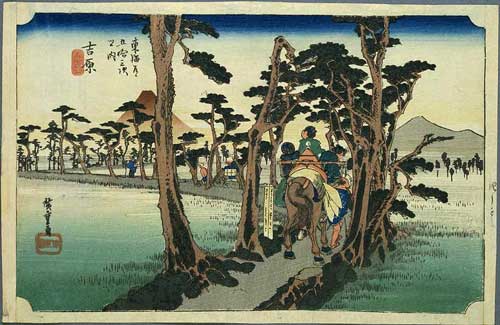
|
Title |
ケンペルの旅行記(4)ー 貧しい村 |
|
Unit/Activity No. |
Tokaido Unit 3/Activity 6 |
|
Topic |
History, travel |
|
Function |
Describe, extract details |
|
Focus |
Understand the description of people's behaviors |
I. BACKGROUND INFORMATION FOR TEACHERS
Teacher Instructions
Answer Key to Student Activities
|
2. |
1)子供達 2)子供達 3)子供達 4)ケンペル 5)子供達 |
|
3. |
300けんほどの小屋が建っている、(子供達は)何回もとんぼがえりをしてはねまわり、金をねだる、お金を投げてやると、子供達はあらそって拾った。 |
|
5. |
上から2番目(武士の次)、85%、幕府が年貢をおさめさせたり、きまりを作ったりして農民をきびしくとりしまった(参考:きまりには次のようなことが書かれていた:1.朝から晩までどんな仕事でも気をぬかないこと 2.麻と木綿の着物のほかにきてはいけない 3.麦・あわ・ひえなどを食べ、米を多く食べないようにしなさい 4.酒や茶を買って飲んではいけない) |
II. STUDENT ACTIVITY HANDOUTS
ケンペルの旅行記の一部を読んで、質問に答えてください。
浜松から江戸への旅(4)
元吉原(もとよしわら)は貧しい村で、300けんほどの小屋1が建って2いる。村の子供達が、私達の乗った馬やかごにかけよって来た。私達の前で、何回もとんぼがえり3をしてはねまわり4、金をねだる5。お金を投げてやると、子供達はあらそって6拾った。旅人はよく貧しい子供達に小銭をやる。小銭7はまん中に穴8があいている。人々は穴にひもを通して9、馬にむすんで10旅をしている。
<Useful Vocabulary>
|
1. 小屋: hut |
2. たつ:build |
3. とんぼがえり: cartwheel |
|
|
4. (が)はねまわる: romper |
5.(を)ねだる: asking for donation |
|
|
|
6. あらそう:to compete |
7. こぜに:penny |
8. 穴: hole |
|
|
9. 〜にひもを通す: run a string through |
10. (を)むすぶ: tie |
||
1. 文章を一度読んで,Pre-reading activity で想像したものが合っているかどうか、調べなさい。
2. 次の行動をしたのはケンペルですか。子供達ですか。あてはまるものをまるで囲んでください。(こうどうする:to take an action)
|
1)馬やかごにかけよって来る。 |
(ケンペル、子供達) |
|
2)とんぼがえりをしてはねまわる。 |
(ケンペル、子供達) |
|
3)金をねだる。 |
(ケンペル、子供達) |
|
4)金を投げる。 |
(ケンペル、子供達) |
|
5)金をあらそって拾う。 |
(ケンペル、子供達) |
3. 文章中の元吉原が貧しいとわかるところに線を引きなさい。
4. 旅人が小銭を持ち運んだ様子を絵に描いてください。
5. 江戸時代には元吉原の人達のように貧しい農民がたくさんいました。脳門は士農工商で何番目の階段にいましたか。人口の何パーセントが農民でしたか。農門はどうして貧しかったと思いますか。
III. VISUAL AIDS FOR TEACHERS
Transparency 1

Pre-reading activity
これから読む旅行記(4)は「元吉原(もとよしわら)は貧しい1村で」と始まります。ケンペルは村の様子2と、ケンペルたちを見たときの村の子供たちの様子を描写します3。どう描写しているかペアで想像して4ください。
1. まずしい:poor 2.ようす:appearance 3.びょうしゃする:to describe
4.そうぞうする:to imagine
Transparency 2
For this visual aid, make a transparency of the handout.